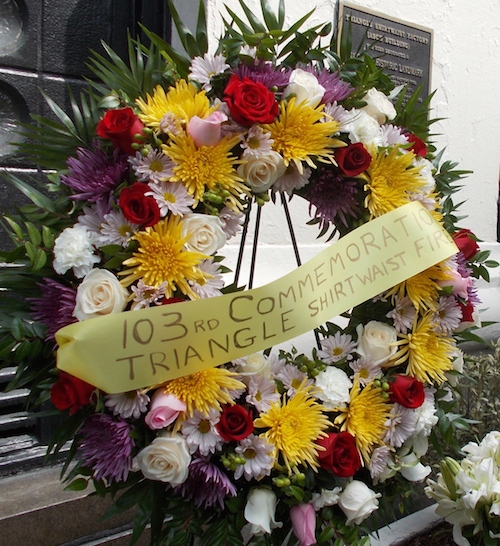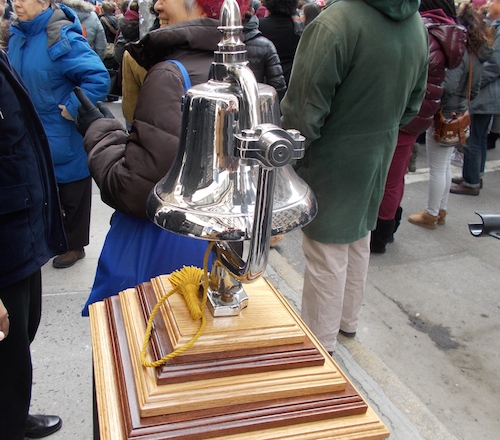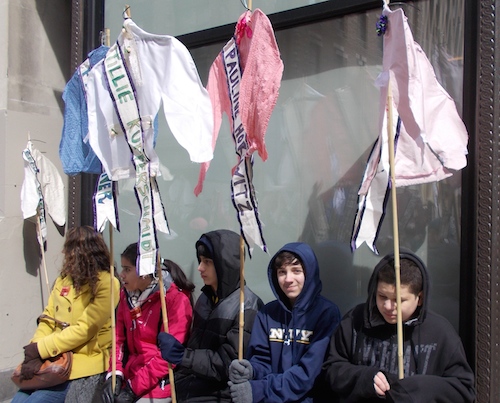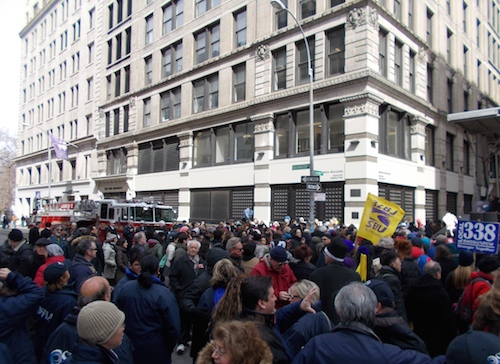New York City Observes 103rd Anniversary of Triangle Fire
On March 25 the City of New York looked back at the tragic events that took place 103 years ago in a sweatshop known as the Triangle Shirtwaist factory. A crowd of 500 took part in the observance, which was held at the site of the tragedy.
Prior to the horrific events of 9/11, the Triangle Fire was the worst workplace disaster in New York City history. On March 25, 1911, a fire raged through the Triangle Shirtwaist Company factory located on the eighth, ninth and tenth floors of the Asch building, on the corner of Greene Street and Washington Place.
The fire killed 146 workers, most of them teenaged women who were Italian or Jewish immigrants. The fire broke out in a bin of fabric and spread quickly. There were no sprinkler systems or extinguishers to put out the fire. Exit doors were locked. For many, the only way to escape the searing heat and biting flames was to jump out one of the factory’s windows or down one of its elevator shafts. Many people chose to do so, preferring that form of death over incineration. Later, inside the factory, heaps of bodies were found piled up near the sealed exit doors. In a desperate attempt to escape the flames, some of the women had actually tried to claw through the doors with their fingernails.
As the tragedy was unfolding, the fire department and passersby tried to help. But there were no fire escapes other than one that had quickly wilted from the heat; and the longest fire ladders in the city reached only to the seventh floor. Some firefighters and citizens made makeshift nets to try to catch the jumpers, but they were unable to stop the fall of human bodies from that kind of height. In the end, 146 workers died, tragically and horribly.
The city was shocked by the incident. Citizens from all walks of life were outraged. Thousands lined a West Side pier that served as a temporary mortuary for the charred bodies. Some of the victims’ remains were so disfigured identification was impossible.
Street rallies were held. Calls were made for reform. The outcry was so voluble and widespread that public officials had no choice but to listen and to act.
In the days following the incident it was learned that the doors of the factory were locked to keep union organizers from visiting the workers. The fact that a union busting tactic resulted in the deaths of 146 workers further angered the populace, while it strengthened public perception of unions. Pressure was put on public officials and employers to respect the rights of workers to organize. Previous to the time of the fire, police had often been ordered by political bosses to beat up strikers. Now they were reminded that workers had a legal right to picket.
One of the first statutory steps taken after the fire was to create the civil service system. At the time of the Triangle tragedy most municipal jobs, including firefighters, were filled by political appointment rather than through a testing system. This led to incompetence and graft in many areas of government work. A more competent fire department, it was noted, might have saved more lives during the Triangle fire and, more likely, might have prevented the tragedy from occurring altogether. Advocates of a civil service system said it would nurture an attitude of responsibility in those that served the public. Many agreed. The New York City Fire Department was turned into a civil service employer as a result of the Triangle fire.
Another important impact of the Triangle fire was that new workplace safety laws were passed. This trend continued and it later led to the workers compensation system, additional workplace safety and health statutes and, eventually, the creation of OSHA.
Today, throughout hotels and other buildings in the city there are exit doors with panic bars on them. There are exit signs that can be seen in the dark and even through heavy smoke. There are fire extinguishers everywhere in these buildings. These and many other safety reforms were instituted as a result of the Triangle fire.
Each year on the anniversary of the Triangle fire a memorial service is held at the scene of the tragedy. At this year’s service, as schoolchildren and union members each deposited a flower in front of the Asch Building, a fire bell tolled in memory of each of the victims.
Among those who spoke at this year’s memorial service were New York City Comptroller Scott Stringer, Public Advocate Letitia James and City Council Speaker Melissa Mark-Viverito. Each of them spoke about the importance of unions and the enforcement of workplace safety laws. They, and all the other speakers, recalled that almost all of the victims of the Triangle Fire were immigrants and that the U.S. today is in serious need of immigration reform, with many undocumented workers employed in unsafe workplaces at pay rates that are below the minimum wage.
The memorial service was a somber event. But it was also inspiring. The Triangle fire happened 103 years ago, and it is inspiring to realize that New York City still remembers 146 of its fallen. The annual memorial service, combined with the enactment of laws that supported union organizing and promoted workplace safety, are our city’s way of saying that these immigrant women did not die in vain.
Every year on March 25th — for 103 years — a wreath has been placed at the scene of the tragedy.
A fire bell was tolled 146 times on March 25th, with the announcement of the name of each of the victims.
Schoolchildren held shirtwaists—a fashionable article of clothing in the early decades of the 20th century—each one containing the name of one of the 146 victims of the Triangle Shirtwaist Factory fire.
Hundreds of New Yorkers gathered outside the Asch Building on March 25 to commemorate the Triangle Factory fire that, prior to 9/11, was the largest workplace disaster in the city’s history.






